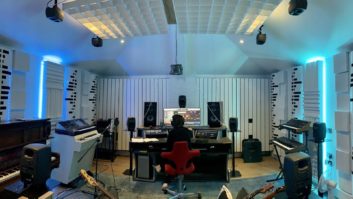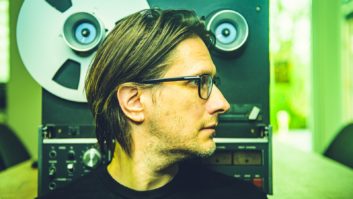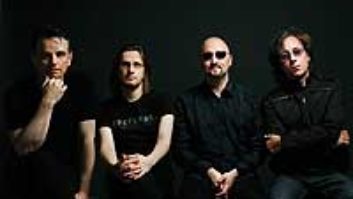It is rare these days that a band hits the mainstream combining the power to rock ferociously with an intellectual, arty vision. Yet, for more than a decade in the underground, England’s eclectic Porcupine Tree has done just that, recording and performing frontman Steven Wilson’s innovative amalgamations of rock, prog and electronica. Now, the quartet is making bigger waves with their latest epic, In Absentia (Lava), a memorable collection of songs that continually shifts and mutates, yet ultimately weaves a cohesive aural tapestry.
“It’s long overdue that we have some progressive music with the kind of depth that it’s had in the past, but without so much of the noodly stuff,” declares engineer Paul Northfield, who worked on In Absentia right after tackling Rush’s impressive Vapor Trails. He notes that while the progressive rock genre is creative, it can sometimes also be ostentatious, yet he believes that Wilson has “managed to avoid that and make something that’s a nice hybrid of the best things about progressive music and what’s going on these days.”
In an era when the term “progressive” is shunned by many music listeners who think it implies over-indulgent, highly technical rock, In Absentia offers a bold rebuttal. Certainly, the record features longer songs and experimental explorations, but it’s all wrapped up by Wilson’s keen melodic sensibilities: The man understands the value of good hooks.
In Absentia is a departure for Porcupine Tree for a number of reasons. It is the group’s major-label debut and, hence, its first with a big budget, which opened up greater recording possibilities. It is the band’s first album geared specifically toward the American market. Wilson believes that “American rock records sound better than any other rock records in the world.” (Ironically, the album was engineered by two Brits living in America.) Finally, Wilson notes that the new album has “a slightly harder, darker, more experimental edge than perhaps the two that preceded it,” which should let fans know that it is certainly no sell-out. Gone are the obvious homages to Pink Floyd that marked some of Wilson’s earlier songs; this is a more distinctive sound all the way around.
Due to financial constraints, Wilson recorded his group’s previous albums in his bedroom studio, where he learned how to get the best sound with his limited resources. With Northfield’s help on the new album, however, Wilson was able to concentrate more on creating and less on technical matters.
“I’ve always had to muddle through on my own in the past,” the singer, songwriter and guitarist reveals, “and I don’t know a lot about which microphone I should use on this guitar amp or on this snare drum. I wouldn’t have a clue, and it’s always been very much trial-and-error. Now for the first time, I was actually working in a great drum room with a great engineer that knew how to mike up and get the best out of a drum kit and get a good guitar sound. So, I certainly learned a lot from that. People have listened to our records and have generally agreed that this is the best-sounding sonically that we’ve ever made. I would certainly hope that’s the case because we spent a lot more money on it.”
At Wilson’s home studio, dubbed No Man’s Land, he recorded demos using a Mac G4 with a 24-bit, 48-track Logic Audio system, a couple of valve mic preamps, a Neumann U87 mic and Logic plug-ins. “In some senses, home recording has completely revolutionized the whole concept of recording,” Wilson observes. “In previous years, a demo sounded like a demo, but nowadays, demos can sound pretty close to the finished article. And there isn’t really a great deal of difference for me between recording at home and going into a big studio. The only difference really is the physical space available and the selection of microphones that a studio facility has. So, when we went into Avatar [Studios] in New York, it was really about the space and the atmosphere and the selection of mics. Plus, having Paul available.”
Northfield, who has worked with such prog titans as Gong, Soft Machine and Gentle Giant, was a valuable member of Porcupine Tree’s team. One of the reasons he was picked was because of his experience in recording guitars. He encouraged Wilson to rent guitar gear to get a great collection that would augment the guitarist’s “good but limited resources,” says the engineer.
In a slightly unusual move, most of Wilson’s original vocals from his demos were kept, “although he did change some and add backing vocals when he got back home,” says Northfield. But all of the guitar, bass and drum parts were recut using the original demos as a guide and template. The whole process mirrored the engineer’s work on Rush’s Vapor Trails.
“If you’re happy with stuff in the demo, then why try to re-create it?” Wilson asks. “We worked on top of the demos, and basically it was a case of replacing the drums, bass and the guitars, and then letting Richard [Barbieri, ex-Japan member] do his thing with keyboards over the top.” A few of Barbieri’s keyboard overdubs were recorded during rehearsal sessions at the New Rising studio in Colchester, UK, prior to the band arriving at Avatar.
“The one thing I don’t try and do much with in the demos is keyboards,” continues Wilson, “because I can’t possibly hope to come up with the sounds that Richard can. But, generally, I’ll have a pretty solid arrangement together worked out long before the band gets in the studio, and it seems to work pretty well. We can work very quickly that way.”
In Absentia was recorded in approximately three-and-a-half weeks, during which 16 songs were cut. Twelve made it onto the final album, two others onto a European release, while one more was given to fans free on the band’s Website, www.porcupinetree.com. “The reason it was so quick is because the arrangements were very much mapped out,” explains Wilson. “I just feel comfortable working that way, not [taking] such a journey into the unknown, which kind of scares me. I don’t like that situation: Being in the studio for months, trying to work out how things should go and racking up hundreds and hundreds of thousands of dollars.”
The main impetus to record at Avatar was that it has a great drum room. “It’s a classic,” observes Northfield. “That makes life so easy when you’re tracking drums.” They first cut drums and bass in the drum room on a Neve 8068, then they moved to an SSL 9000 room and re-recorded Wilson’s guitars and added Barbieri’s keyboards. “All of the recording in the SSL room was done using Neve 1073s and Apogee AD-8000s,” Northfield notes. “AD-8000s were also used for all other recording in New York and for playback at the mix.”
Northfield and Wilson recut nearly all of the frontman’s guitar parts, except one or two that had real personality. “I always find the actual miking up of a cabinet pretty straightforward,” explains Northfield. “I just use 1073s and usually Shure 57s to mike guitars. I also use those for acoustic guitars quite often, although usually it’s a combination of a 47 or something interesting. I always like to try a 57 on an acoustic, because if you have a great acoustic and a really excellent preamp, a 57 can be really quite a creative mic. It gives you a little bit of that distortion texture that helps make an acoustic guitar cut through in a rock track. Sometimes, if you go too hi-fi with your miking on an acoustic, you end up with a beautiful, James Taylor-y guitar sound that never fits properly in a rock track. You can find it overwhelmingly loud, and then you end up putting a lot of compression on it. Sometimes just grabbing a Shure gives you a simplicity and a focus on the sound that really can work quite well. It’s a good trick. You probably shouldn’t write about that trick because it’s top secret.”
To record Colin Edwin’s bass, Northfield used a number of different Ampeg bass cabinets and amps. “I think the B4B was the main bass amp with an 8×10 bass cabinet,” he recalls, “and also various distortion effects sometimes to give a fatness to the bass sound, which is quite handy.” For the rented DW drum kit that Gavin Harrison played, Northfield used a 57 on the snare, 421s on the toms, a 47 and a D112 on the bass drum, “with fairly close double-heads on the bass drum but with probably an air hole in it, but not a large one; just enough to get the mic stand through.” AKG C12s and B&Ks were used for overheads. He recorded a total of 16 tracks of drums, with one mic for each track.
In Absentia was recorded onto Logic software with a Pro Tools hardware rig, with as many as 48 tracks’ worth of audio on certain songs. Wilson proudly points out that no digital keyboards were used at all. Instead, there was a Hammond organ, Mellotron, Fender Rhodes and Barbieri’s collection of analog synths, which includes a Prophet 5 and a Roland System 700. “I do think that gives the record a more organic and hopefully more timeless quality,” says Wilson. “It’s not going to date in the same way that digital instrumentation tends to date records.”
Strings for the album, arranged by former XTC member Dave Gregory, were recorded at George Martin’s Air Lyndhurst studio in London. Extra vocal and guitar parts were contributed by John Wesley and were recorded by Wesley himself in Red Room Recorders in Tampa, Fla. Wilson sent him slave tapes; then, Wesley recorded his parts and sent them back.
The album was mixed by Tim Palmer with engineer Mark O’Donoughue at Larrabee North in North Hollywood. “I had my G4 system sent over to L.A.,” recalls Wilson, “and we literally just split out all the outputs. A lot of the sounds already had plug-in treatments set up on the Logic system.” In Absentia was mixed on a J Series console at the rate of one track per day for 16 days.
The finished album has proven to have strong appeal to many critics, even those who might not normally listen to progressive rock. The band opened up a North American tour for Yes last fall (and reportedly received a warm reception) and should be returning to the States this spring following an extensive European tour. All of this activity will no doubt further expose their music to American listeners eager to embrace such adventurous sounds.
“The special thing about the album is what’s fairly evident from just listening to it: the drama and dynamics and the contrasts,” remarks Northfield. “I tend to gravitate toward experimental or indulgent music. I really like it. Rather than get lost in noodly bits, [this album] always came back to the strong, forceful rock base, so that was the most attractive thing about working on it. At the same time, we were able to be more texturally esoteric, as opposed to just sticking with guitar, bass and drums, which I’ve done a lot of and which is a different kind of aesthetic.”
“For me,” Wilson adds, “that golden era of experimental rock music that was born with Pet Sounds and Sgt. Pepper’s, and died when punk rock came along at the end of the ’70s, is something I really try to re-create with our records to an extent, albeit in a very contemporary setting.”





